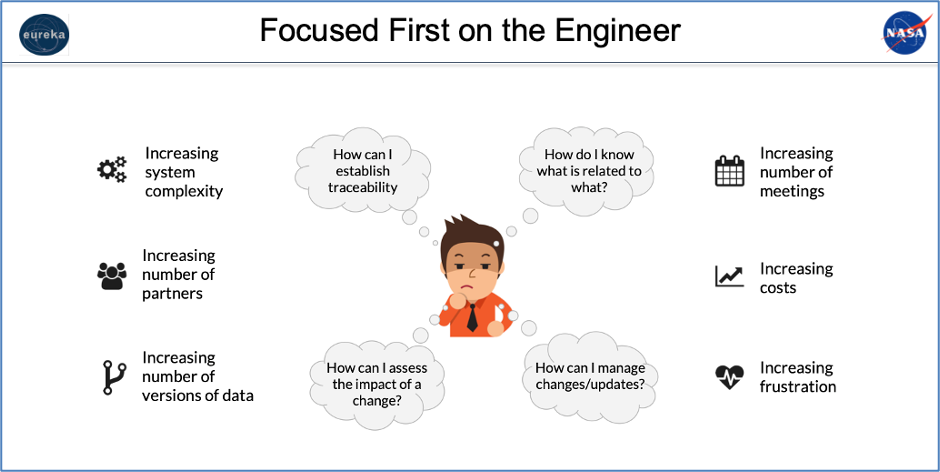Eureka Interactive Model Based Decision Tool for Space Architectures
If we’re going to realize the promise of Model Based Systems Engineering (MBSE), we need to solve knowledge problems for engineers and mission planners. They are working on a complex set of interrelated issues with expensive consequences. The stakes are huge, in time, budget, technical risk and safety. In 2018, Chris Crumbly of IDEA pulled together his team, Purdue University, and Bintel to attack this challenge. Below is a summary of the project which had a successful out-brief in late 2019. Current initiatives with NASA plan to extend this work in 2023.
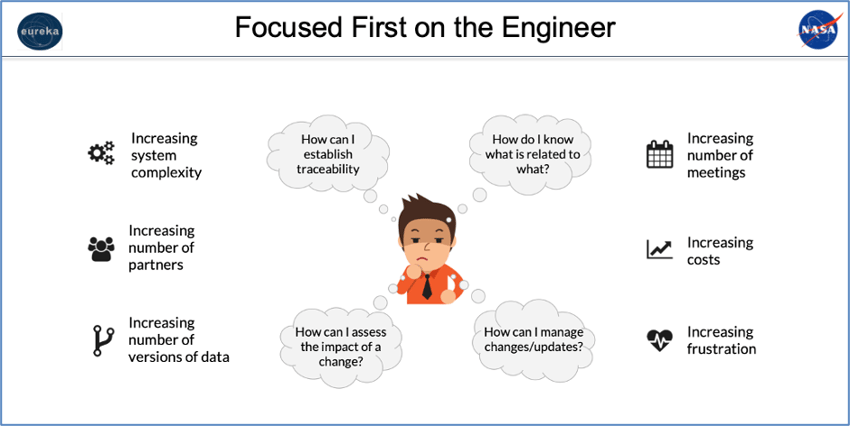
Figure 1: Focus on the Engineer
Focused on the Engineer, Eureka’s goal was to enhance the SoS analysis toolset by integrating Artificial Intelligence (AI) and formal MBSE, including:
- Develop and validate AI agents for the dynamic and ongoing collection of pertinent information related to the systems in each architecture, to complement and enhance information from Subject Matter Experts.
- Develop methods to rapidly ingest and analyze architectures from multiple sources including formal MBSE-based architectures and systems developed in different MBSE SysML tools.
- Test & tune the enhanced toolset using an AI generated/curated Space Architecture Database.
- Begin the development of a digital thread that can link technology status and architecture analysis to requirements and systems development.
Project Description And Technical Approach
This project named “Eureka – Model Based Systems Approach for Space Architecture Definition” led by the Von Braun Center for Science & Innovation (VCSI) is represented in the figure below and sought to integrate work done by Purdue University and Bintel under previous separate contracts. This effort included making the output of the models readily available to the mission or systems planner using the application “dashboard” with the ability to modify key parameters such as risk level and schedule.
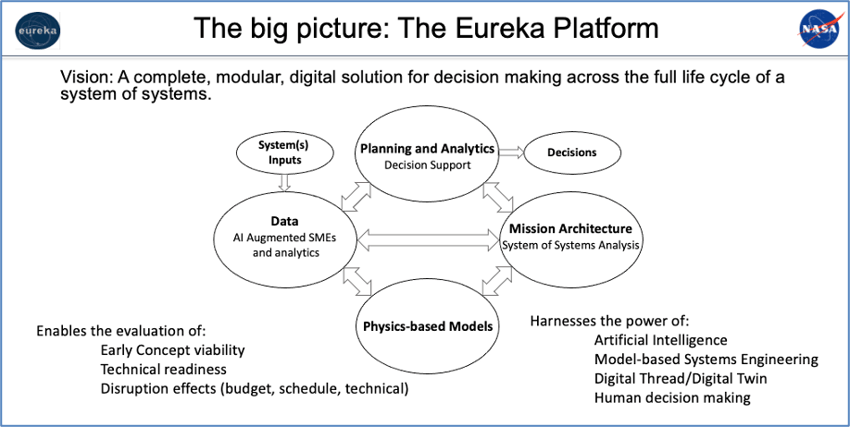
Figure 2: The Eureka Vision
The problem addressed by the Eureka team is the mitigation of risk by forecasting issues related to budget, schedule, and Technology Readiness Level (TRL). The scope included tools for investigating system dependencies and providing engineers with the most relevant and up-to-date research for each system. All of this information is viewable in one location for convenience and quick understanding by program and project management. An application with customized interactive dashboards provides the ability to assess project risk at a high level and be able to drill down into granular detail when desired.
Given the volume and velocity of data and inputs required to make critical decisions and systems selections, the Eureka dashboards allow personnel at all levels of a project to make sense of the data and view the information that is specific to them quickly and efficiently, including:
- Interactive mission planning dashboards
- Data from the parametric space architecture models
- Access to the AI Topic Agents and tools for researching critical technologies
To achieve this result, Eureka sought to focus on improving the existing space architecture models, updating and improving the artificial intelligence agents, and connecting these components to the mission planning dashboard. Our use case for the demonstration of the support capability of the Eureka system focused on the architecture, systems, and technology trades surrounding cryogenic systems and cryogenic system technologies.
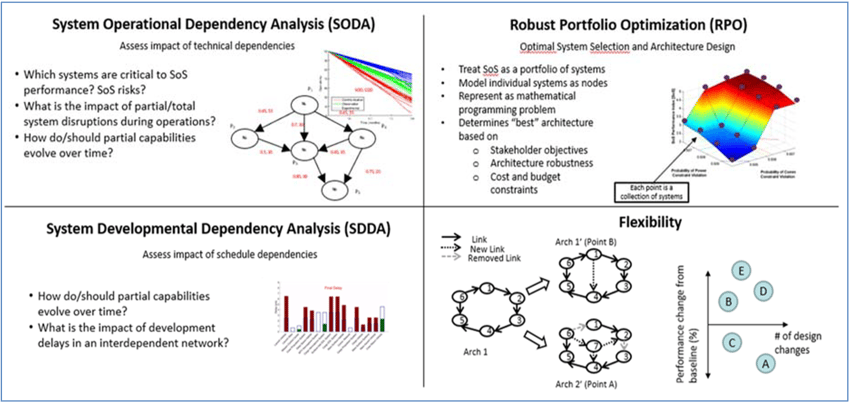
Figure 3: The AWB Suite: SODA, SDDA, RPO, and Flexibility
The Purdue AWB Suite
The Eureka incorporated Purdue University’s powerful modeling system that introduces the data recovered by artificial intelligence topic agents and validated through Subject Matter Experts (SME) into a suite of systems of systems (SoS) analysis tools to create a space architecture model. Key engineering tools that may be applied include the Systems Operational Dependency Analysis (SODA), the Systems Development Dependency Analysis (SDDA) tools, Robust Portfolio Optimization (RPO), and Flexibility Analysis:
- SODA is a method to analyze the result of the possible cascading effect of dependencies between systems on the overall operability, in case of disruptions, and to support design decision-making. This provides a parametric model of the behavior of the system.
- SDDA is a method to assess the impact of partial developmental dependencies between components in a complex system, or between systems in a system of systems.
- RPO is a tool to optimize systems selection from available portfolios, based on objectives, operational constraints, cost, and risk acceptance.
- Flexibility Analysis is a methodology to compare architectures based on the amount and cost of modifications necessary to switch between different architectures.
The Five Steps to a Parametric Model for a Space Architecture
Building out the SoS Models and providing the results for mission and engineering analysis consists of five steps shown in the figure below. Eureka project validated the use of AI Topic Classifiers as a means to accelerate the first and second steps. Steps three and four build the relationships and dependencies needed for the final analysis and visualizations.
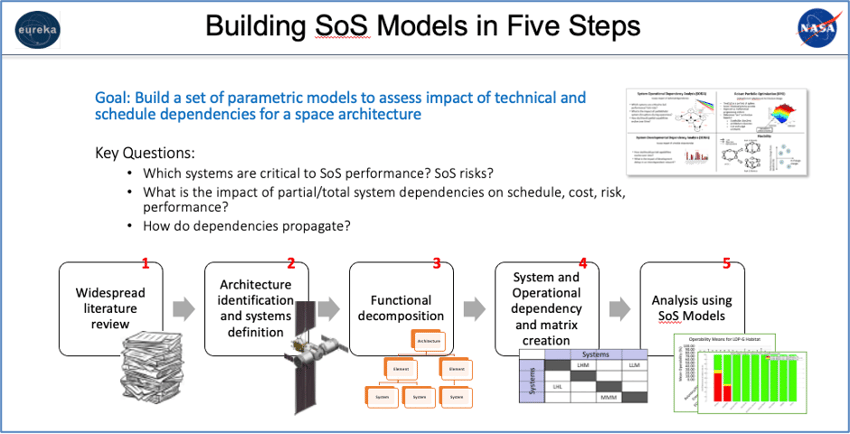
Once the Five Steps are completed, the “So What?” questions can be addressed
Subject Matter Experts can then assist in the research, parametric ranges, and associated impact to the cost, risk, operational dependencies, and schedule components of an architecture. This will facilitate rapid what-if analysis:
- What are impacts to risk from changes in:
- TRL, budget (SDDA)?
- flexibility, mission focus (all)?
- performance (RPO, SODA)?
- When to change budget?
- When to change entire architecture for a mission?
- When to change mission?
A benefit discovered in the Topic-Mapper Project was that the AI Topic Agents not only found the technology that the engineer requested, but also discovered applicable technologies not originally considered by the engineer. New research is constantly improving technologies and this feature enables an engineer to stay current with the latest advancements. Human-in-the-Loop workflows remain central to the proposed solution but are leveraged to produce an improved result.
Integration with SysML Applications can Speed the Research Process
Another technical goal was to capture documented information from the Model-Based System Engineering (MBSE) process (SySML tools) to speed the process. Topic mapping provides an ability to group or cluster documents and paragraphs that enable the creation of enriched index/linking for Digital Thread (DT). The Eureka Digital Thread/Knowledge extension (Ke) will provide the infrastructure to support the building of information containers and Knowledge Networks.
Deliverables
The project technical approach and deliverables were executed collaboratively with the MSFC Partnerships and Formulation Office. The Eureka team documented findings, recommendations, and conclusions of these studies, proving the value of use of AI as well as the integration of several lines of effort by Purdue University and Bintel.
Use of the Eureka Solution will support mission planning and technical decision making in the areas of cost, schedule, and risk considering interdependencies within the system, thereby accelerating mission schedules and reducing cost/risk.
The project resulted in several papers presented to the IEEE Aerospace Conference. A member of our team also published a related paper on verification of climate claims. They are listed below:
- Guariniello, T. B. Marsh, T. Diggelmann, and D. A. DeLaurentis, “System-of-Systems Methods for Technology Assessment and Prioritization for Space Architectures,” in 2021 IEEE Aerospace Conference, IEEE 2021.
- Guariniello, T. B. Marsh, R. Porter, C. Crumbly, and D. A. DeLaurentis, “Artificial intelligence agents to support datamining for SoS modeling of space systems design,” in 2020 IEEE Aerospace Conference. IEEE, 2020, pp. 1–11.
- Diggelmann, J. Boyd-Graber, J. Bulian, M. Ciaramita, M. Leippold, “climate-fever: A Dataset for Verification of Real-World Climate Claims," arxiv.org/abs/2012.00614, 2020.
Related Projects for NASA
This project was one of a series that validated technical research using multiple taxonomies and ontologies. This approach and additional lessons learned have resulted in Portfolio Investment Analysis, a cost reduction project for the RS-25 Engine, Engineering Research Support for Model Based Systems Engineering and several competitive intelligence projects. This work led to the development of Bintel’s Commercial Strategy Platform and is being applied to the identification and quantification of the Space Innovation Ecosystem (SPIE). More information is available on the Bintel website.
Summary
The NASA taxonomy combined with interactive search and discovery provide a flexible and fast research methodology for sustained growth in space, aerospace, robotics and the emerging ecosystems driving our future. This application is being used for academic and commercial projects that seek to understand how they fit into NASA’s missions and sustainability initiatives across multiple industries.

